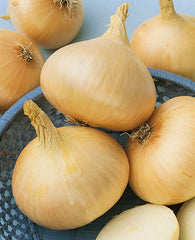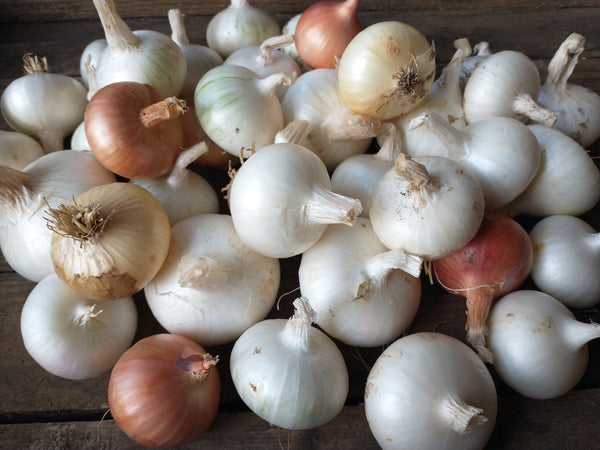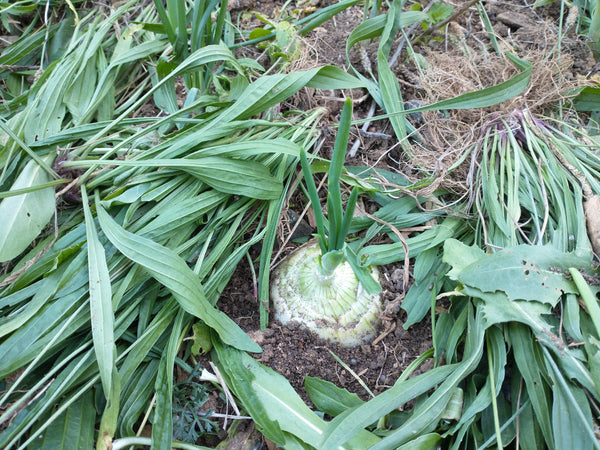Potato Onion
Allium cepa
HOW TO GROW ONION
Start indoors 8–10 weeks before last frost, plant out 4 weeks before frost. For fall harvest, transplant 11 weeks before first frost. Short-day onions produce bulbs in 11-12 hours of light, long-day onions in 14-16 hours. The dividing line is 36˚, about the KA/OK border. Plant long-day varieties north of this line and short-day south. Direct sow thickly as soon as soil can be worked. If tops reach 5” before transplant, cut to 1-3” to increase girth. Transplant seedlings in shallow trench 2-7” apart. Hill sides slightly after 4-5 weeks. Knock the rest of the tops over when 60 percent have fallen. After 3 days, pull and sun-cure 7–10 days in field rotating every few days before twisting off tops and storing. Soil pH 6.2-7.5. Hardiness zones 3-10. Biennial.
Days from maturity calculated from the date of seeding. Average 6,500 seeds per ounce. Average 580M seeds per acre. Federal germination standard: 70%. Usual seed life: 2–3 years. Isolation distance for seed saving: 1 mile.
Planting Depth 1/8-1/4”
Soil Temp. Germ. 55-75˚F
Days to Germ. 7-14
Plant Spacing 4-8”
Row Spacing 12-18”
Storage Refrigerate
Full Sun, Moist Well Drained
Days from maturity calculated from the date of seeding. Average 6,500 seeds per ounce. Average 580M seeds per acre. Federal germination standard: 70%. Usual seed life: 2–3 years. Isolation distance for seed saving: 1 mile.
Planting Depth 1/8-1/4”
Soil Temp. Germ. 55-75˚F
Days to Germ. 7-14
Plant Spacing 4-8”
Row Spacing 12-18”
Storage Refrigerate
Full Sun, Moist Well Drained
- 100 Seeds$4.10
- 1000 Seeds$21.50
Potato onions are a perennial bunching onion with nice sized bulbs. Potato onions can be grown season after season similar to shallots. Like shallots, larger potato onions will start dividing after their first season of growth. This selection includes mostly white onions, but some of the onions have brown or even li...
Potato onions are a perennial bunching onion with nice sized bulbs. Potato onions can be grown season after season similar to shallots. Like shallots, larger potato onions will start dividing after their first season of growth. This selection includes mostly white onions, but some of the onions have brown or even light red skins.These potato onions are delicious, spicy and exceptionally good storage onions. They will keep for up to 12 months if stored on a shelf in a single layer with good air circulation in a cool room/garage/cellar. They also over-winter very well in our zone 7 winters but grow larger when we harvest, divide, cure and replant the onions in the following season. When grown from seed, onion bulbs can get quite large in their first year (up to and larger than baseball size) under the right conditions.Potato onions can also be grown as annuals from seed as you would grow any other standard onion, and they do very well that way. When grown perennially, I am finding that many of the first year onions will flower and go to seed in their second year. Larger onions that are replanted will divide into a "nest" of 4-8 new onions.Harvest 1st year onions when about half of the tops have fallen over, cure the onion and store in a dry cool room. For 2nd+ year onions, wait until after the onions finish flowering and wait until after summer solstice to harvest because the onions will bulb up a bit more.It will appear as if the flower stalk comes from the center of the onion, but it actually comes from below and from the side of the onion, so the stalk can be pulled away from the onion and it stores well. There is a small percentage of onions where the flower stalk does grow from the center.You can grow perennial onions indefinitely this way but the cloned onions will no longer produce seed and may become successively smaller over several years until they reach shallot size onions due to fungus and disease. You can break the disease cycle by dipping the cured bulbs in a 1:9 bleach to water solution for 5-10 minutes before planting. You can also break the disease cycle by planting from seed since seed.The origin of our potato onion genetics comes from from Andy Hahn who is continuing the work started by Kelly Winterton. After a rare flowering of his potato onions, Kelly saved the seed and spent years breeding and distributing seed, bringing this once popular, but now rare form of onion back from obscurity! Tags: Harvest: Mid, Size: Medium, Specialty: Storage, Heritage: Heirloom, Season: Spring Fall.
Learn More
Meet Your Farmer
We promote fair trade, organic practices and environmental responsibility throughout the Restoration Seeds supply chain. Below are the family farmers and seed suppliers who bring our open pollinated seeds to you.
Idyllwild
Conventional
Seed grower since 2018
![]()
Idyllwild was born of our joyful curiosity and celebration of nature’s diverse gifts. Following nature’s model of open dispersal and dissemination, we share these seeds with you and invite you to play in the garden of abundance. We learn from nature and she has taught us to live and think in terms of “abundance” instead of “scarcity”. Diversity - in all forms, from genetic to creative expression - is the heart of resilience. We enjoy experimenting with myriads of flavors, colors, and textures and the world opens to us in infinite possibilities. As a result, we are nourished in body, mind, and spirit.
Reviews
Customer Reviews
Based on 2 reviews
Write a review













